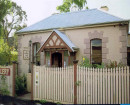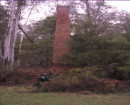Back to search results
Marina, Japanese Tea House & Garden
678 Esplanade,, MORNINGTON VIC 3931 - Property No B7325
Marina, Japanese Tea House & Garden
678 Esplanade,, MORNINGTON VIC 3931 - Property No B7325
All information on this page is maintained by National Trust.
Click below for their website and contact details.
National Trust
-
Add to tour
You must log in to do that.
-
Share
-
Shortlist place
You must log in to do that.
- Download report
On this page:
Statement of Significance
What is significant? Marina is an Arts and Crafts style house built in1915 by noted horticulturalist Joseph Harris to replace his 1876 house, which was destroyed by fire. The garden immediately around the house includes plantings by Harris from the late 19th century, and is all that remains of his once large estate.
Marina is located on the clifftop above Marina Cove, named after the house. His property originally extended to the intersection of the Esplanade and Strachans Road, where the Joseph Harris memorial is now situated, which was once known as 'Harris's Corner'.
Joseph Harris ran several Melbourne nursery businesses and had become a notable horticulturalist and politician by the late 19th century. He was Mayor of Prahran in 1875, Member of Parliament from 1889 to 1894, was on Melbourne's Metropolitan Parks and Gardens Committee, was involved in the founding of the Burnley Horticultural Society, and was a Commissioner for the 1888 Melbourne International Exhibition (and Chairman of its Gardens Committee).
Harris created one of the earliest 'public gardens' in Victoria, now the Joseph Harris Scout Park, on an 80 acre site he bought in 1876 at Mt Martha. He planted it with numerous Mediterranean trees, and was involved in the planting of similar trees in the adjacent Mt. Martha Park.
Also in 1876 he purchased a large waterfront property south of the Mornington township and built a six-roomed 'marine villa' holiday house, later known as Marina. By 1903 he had established an ornamental garden of 12 acres around the house, embellished with a Japanese tea house, probably part of the 1888 International Exhibition. Caught up in the crash of the 1890s, he became insolvent in 1895, and retired to Marina in 1896, where he died in 1925. His daughter Rose inherited the property, remaining there until her death in 1957, when the whole property was purchased by the housing commission, and subdivided. The house and immediate garden remained on 3 lots, bought in 1958 by Phillip and Bette Misken, and inherited by their children in 2003.
The house is a gabled bungalow with Arts and Crafts elements such as the simulated half-timbered roughcast walls, tapered roughcast chimneys and low-set windows above a weatherboard plinth. The porch on the west is simple, but relatively unusual in that it is inset under the main roof, rather than having a separately expressed roof.
The property is entered off the Esplanade with a long sweeping driveway flanked with Cypress trees leading to the west-facing porch, and the house is surrounded by garden beds, a large lawn, mature Palms and a Norfolk Island Pine. The original 19th century front gate is removed, but stored on site.
The Japanese style tea house lies at the southern end of the garden. It is a small gable roofed timber structure with a (later) shingled roof, with walls of either vertical lattice or simulated bamboo construction painted green and a simulated lacquered maroon, highlighting its various parts. Sections of the walls are white panels which presumably can be demounted. At each end of the building there is a shallow projecting bay with a separate lower roof, bracketed off the main structure at the base. The short lower roofs have curved externally expressed 'rafters'. Internally the building is one small room, the walls lined with plywood which may not be original.
How is it significant? Marina and its garden are significant for aesthetic/architectural, and historic reasons at the Regional level.
The Japanese Tea house is of aesthetic. Architectural and historical significance at the State level.
Why is it significant?
Marina is historically and socially significant as a house and garden built by notable nurseryman, horticulturalist and politician Joseph Harris. He was a notable citizen in Melbourne, particularly in the horticulture business, but had a particular influence in the Peninsula area. His plantings of tree species such as Monterey Cypress, Hoop, Bunya Bunya, Stone and Norfolk Island Pines etc. were emulated and form the basis of many mature Mediterranean pinetree garden landscapes on the Peninsula.
Marina is significant as one a few early 20th century 'marine villas' on the Esplanade. Today Marina retains the core of its original 12 acre garden on its present landholding including part of the original garden and the Japanese Tea house, and is one of the few larger landholdings on the Esplanade.
The house has aesthetic significance as a virtually intact Arts and Crafts style Federation house with distinctive architectural features not typical of the style, with relatively elaborate and unusual interiors. The significance of the house is enhanced by its 19th century garden setting, planned and planted by Harris himself.
The garden is aesthetically significant in its own right for its plantings, layout, and the 19th century timber gate (stored on site).
The Japanese Tea house has special significance as most likely being part of the International Exhibition held at the Exhibition Buildings in 1888. It would therefore be one of the few items remaining from that exhibition, as well as the only 19th century Japanese style Tea house in Victoria. If it is in fact from a later period, it is still a particularly elaborate garden structure in a most unusual style and a thorough version of that style.
Marina & Garden Classified: 'Regional' 23/10/2006
Japanese Tea House Classified: 'State'
Teahouse only, classified by Heritage Victoria
Marina is located on the clifftop above Marina Cove, named after the house. His property originally extended to the intersection of the Esplanade and Strachans Road, where the Joseph Harris memorial is now situated, which was once known as 'Harris's Corner'.
Joseph Harris ran several Melbourne nursery businesses and had become a notable horticulturalist and politician by the late 19th century. He was Mayor of Prahran in 1875, Member of Parliament from 1889 to 1894, was on Melbourne's Metropolitan Parks and Gardens Committee, was involved in the founding of the Burnley Horticultural Society, and was a Commissioner for the 1888 Melbourne International Exhibition (and Chairman of its Gardens Committee).
Harris created one of the earliest 'public gardens' in Victoria, now the Joseph Harris Scout Park, on an 80 acre site he bought in 1876 at Mt Martha. He planted it with numerous Mediterranean trees, and was involved in the planting of similar trees in the adjacent Mt. Martha Park.
Also in 1876 he purchased a large waterfront property south of the Mornington township and built a six-roomed 'marine villa' holiday house, later known as Marina. By 1903 he had established an ornamental garden of 12 acres around the house, embellished with a Japanese tea house, probably part of the 1888 International Exhibition. Caught up in the crash of the 1890s, he became insolvent in 1895, and retired to Marina in 1896, where he died in 1925. His daughter Rose inherited the property, remaining there until her death in 1957, when the whole property was purchased by the housing commission, and subdivided. The house and immediate garden remained on 3 lots, bought in 1958 by Phillip and Bette Misken, and inherited by their children in 2003.
The house is a gabled bungalow with Arts and Crafts elements such as the simulated half-timbered roughcast walls, tapered roughcast chimneys and low-set windows above a weatherboard plinth. The porch on the west is simple, but relatively unusual in that it is inset under the main roof, rather than having a separately expressed roof.
The property is entered off the Esplanade with a long sweeping driveway flanked with Cypress trees leading to the west-facing porch, and the house is surrounded by garden beds, a large lawn, mature Palms and a Norfolk Island Pine. The original 19th century front gate is removed, but stored on site.
The Japanese style tea house lies at the southern end of the garden. It is a small gable roofed timber structure with a (later) shingled roof, with walls of either vertical lattice or simulated bamboo construction painted green and a simulated lacquered maroon, highlighting its various parts. Sections of the walls are white panels which presumably can be demounted. At each end of the building there is a shallow projecting bay with a separate lower roof, bracketed off the main structure at the base. The short lower roofs have curved externally expressed 'rafters'. Internally the building is one small room, the walls lined with plywood which may not be original.
How is it significant? Marina and its garden are significant for aesthetic/architectural, and historic reasons at the Regional level.
The Japanese Tea house is of aesthetic. Architectural and historical significance at the State level.
Why is it significant?
Marina is historically and socially significant as a house and garden built by notable nurseryman, horticulturalist and politician Joseph Harris. He was a notable citizen in Melbourne, particularly in the horticulture business, but had a particular influence in the Peninsula area. His plantings of tree species such as Monterey Cypress, Hoop, Bunya Bunya, Stone and Norfolk Island Pines etc. were emulated and form the basis of many mature Mediterranean pinetree garden landscapes on the Peninsula.
Marina is significant as one a few early 20th century 'marine villas' on the Esplanade. Today Marina retains the core of its original 12 acre garden on its present landholding including part of the original garden and the Japanese Tea house, and is one of the few larger landholdings on the Esplanade.
The house has aesthetic significance as a virtually intact Arts and Crafts style Federation house with distinctive architectural features not typical of the style, with relatively elaborate and unusual interiors. The significance of the house is enhanced by its 19th century garden setting, planned and planted by Harris himself.
The garden is aesthetically significant in its own right for its plantings, layout, and the 19th century timber gate (stored on site).
The Japanese Tea house has special significance as most likely being part of the International Exhibition held at the Exhibition Buildings in 1888. It would therefore be one of the few items remaining from that exhibition, as well as the only 19th century Japanese style Tea house in Victoria. If it is in fact from a later period, it is still a particularly elaborate garden structure in a most unusual style and a thorough version of that style.
Marina & Garden Classified: 'Regional' 23/10/2006
Japanese Tea House Classified: 'State'
Teahouse only, classified by Heritage Victoria
Show more
Show less
-
-
-
-
JAPANESE TEA HOUSE
 Victorian Heritage Register H2203
Victorian Heritage Register H2203 -
Marina, Japanese Tea House & Garden
 National Trust H2203
National Trust H2203
-
-







